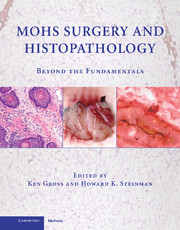Book contents
- Frontmatter
- Contents
- CONTRIBUTORS
- MOHS SURGERY AND HISTOPATHOLOGY
- PART I MICROSCOPY AND TISSUE PREPARATION
- PART II INTRODUCTION TO LABORATORY TECHNIQUES
- Chap. 6 LAB PEARLS: MAKING GREAT SLIDES
- Chap. 7 LAB PEARLS: STAINING, INKING, AND COVERSLIPPING
- Chap. 8 LAB PEARLS: TROUBLESHOOTING SLIDE QUALITY
- Chap. 9 MOHS SLIDES ORGANIZATION AND STANDARDIZATION FOR EFFECTIVE INTERPRETATION
- Chap. 10 MOHS MAPPING
- PART III MICROANATOMY AND NEOPLASTIC DISEASE
- PART IV SPECIAL TECHNIQUES AND STAINS
- INDEX
Chap. 7 - LAB PEARLS: STAINING, INKING, AND COVERSLIPPING
from PART II - INTRODUCTION TO LABORATORY TECHNIQUES
Published online by Cambridge University Press: 03 March 2010
- Frontmatter
- Contents
- CONTRIBUTORS
- MOHS SURGERY AND HISTOPATHOLOGY
- PART I MICROSCOPY AND TISSUE PREPARATION
- PART II INTRODUCTION TO LABORATORY TECHNIQUES
- Chap. 6 LAB PEARLS: MAKING GREAT SLIDES
- Chap. 7 LAB PEARLS: STAINING, INKING, AND COVERSLIPPING
- Chap. 8 LAB PEARLS: TROUBLESHOOTING SLIDE QUALITY
- Chap. 9 MOHS SLIDES ORGANIZATION AND STANDARDIZATION FOR EFFECTIVE INTERPRETATION
- Chap. 10 MOHS MAPPING
- PART III MICROANATOMY AND NEOPLASTIC DISEASE
- PART IV SPECIAL TECHNIQUES AND STAINS
- INDEX
Summary
INKING, STAINING, and coverslipping are the most correctable Mohs laboratory processes in improving slide quality. This chapter will discuss improving tissue ink appearance, enhancing hematoxylin and eosin (H&E) staining, color, contrast, and quality, and preventing air-bubble formation and glue seepage after coverslipping.
INKING (CHROMACODING)
Proper inking (chromacoding) of specimens is critical to the complete removal of skin cancer. Inking performs the dual roles of specimen orientation and specimen margin representation. Every processed piece of tissue must have epithelium or ink around its complete circumference. These indicate to the surgeon-pathologist that all peripheral margins are represented on the slides.
When inking subdivided specimens, the entire cut edges must be inked. It is important to avoid allowing any ink to flow onto the underside of the specimen. The inked edge functions as a surrogate for epithelium, denoting when the full margin is represented on the tissue wafers. If a specimen's underside is inadvertently inked, the technician seeing the ink may mistakenly believe the wafer's complete edge has been reached, indicating that the full margin is represented, and would therefore not cut additional wafers. This would leave the true margin within the tissue freezing medium (TFM), and any tumor in this unrepresented area would be left untreated. Ink accidentally spreading to the underside of the specimen is called “ink bleeding.” Techniques to prevent ink bleeding include:
Careful and deliberate inking.
Placement of the specimen on an absorbent pad or gauze during chromacoding.
Increasing the inks' viscosity.
- Type
- Chapter
- Information
- Mohs Surgery and HistopathologyBeyond the Fundamentals, pp. 57 - 61Publisher: Cambridge University PressPrint publication year: 2009



